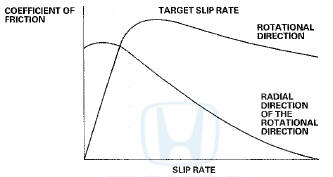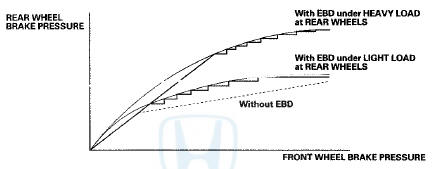 Honda Accord: System Description
Honda Accord: System Description
VSA Modulator-Control Unit Inputs and Outputs for 36P Connector (Connector Disconnected

Wire side of female terminals.


System Outline
This system i s composed of the VSA modulator-control unit the wheel speed sensors, the steering angle sensor, the yaw rate-lateral acceleration sensor, and the system indicators in the gauge control module. The VSA modulator-control unit controls the ABS, EBD, TCS, VSA, and brake assist with the brake pressure of each wheel and reduces engine torque.

ABS (Anti-lock Brake S f stem) Features
Anti-lock Control
Without ABS, when the brake pedal is pressed while driving, the wheels sometimes lock before the vehicle comes to a stop. In such an event, the maneuverability of the vehicle is reduced if the front wheels are locked, and the stability of the vehicle is reduced if the rear wheels are locked, creating an extremely unstable condition. With ABS, the system precisely controls the slip rate of the wheels to ensure maximum grip force from the tires, and it thereby ensures - maneuverability and stability of the vehicle. The ABS calculates the slip rate of the wheels based on the four wheel speeds, and then it controls the brake fluid pressure to reach the target slip rate.
Grip force of tire and road surface

Main Control
The control unit detects the wheel speed based on the wheel speed sensor signals it receives, then it calculates the vehicle speed based on the detected wheel speed. The control unit detects the vehicle speed during deceleration based on the wheel speeds.
The control unit calculates the slip rate of each wheel, and transmits the control signal to the modulator unit solenoid valve when the slip rate is high.
The hydraulic control has three modes: Pressure intensifying, pressure reducing, and pressure retaining.

EBD {Electronic Brake Distribution) features
The EBD feature helps control vehicle braking by adjusting the rear brake force in accordance with the rear wheel load before the ABS operates. Based on the wheel speed sensor signals, the control unit uses the modulator to control the rear brakes individually. When the rear wheel speed is less than the front wheel speed, the VSA modulator-control unit retains the current rear brake fluid pressure by closing the inlet valve in the modulator. As the rear wheel speed increases and approaches the front wheel speed, the VSA modulator-control unit increases the rear brake fluid pressure by momentarily opening the inlet valve. This whole process is repeated very rapidly. While this is happening, kickback may be felt at the brake pedal, you may also hear a muted buzzing sound from the VSA modulator-control unit. This is nomal.

TCS (Traction Control S f stem) Features
When a drive wheel loses traction on a slippery road surface and starts to spin, the VSA modulator-control unit applies brake pressure to the spinning wheel and sends an engine torque control request to the ECM/PCM to slow the spinning wheel and keep traction. .

VSA (Vehicle Stability Assist) S f stem Features
Oversteer control
Applies the brakes to the front and rear outside wheels

The brake makes the yaw rate opposite to the turning direction
Underiteer control
- Applies the brakes to the front and rear inside wheels
- Controls the engine torque when accelerating

The brake increases the yaw rate toward the turning direction
The throttle control effect:
- Reduces vehicle speed
- Increases cornering force
Brake Assist Features
Brake assist helps ensure that any driver can achieve the full braking potential of the vehicle by increasing brake system pressure in a panic situation, bringing the vehicle into a full ABS stop.
If during a panic stop the VSA modulator-control unit determines that the brake system pressure increases above a threshold in less than a certain amount of time, the VSA modulator-control unit engages brake assist Because the brake system pressure crossed the pressure threshold before the time threshold had expired, the VSA modulator-control unit goes into brake assist mode.

Modulator Unit
The modulator unit consists of the inlet solenoid valve, the outlet solenoid valve, the VSA NO (normally open) solenoid valve, the VSA NC (normally closed) solenoid valve, the reservoir, the pump, and the pump motor.
The hydraulic control has three modes of ABS action; pressure intensifying, pressure retaining, and pressure reducing.
Pressure intensifying mode (VSA) is a combination of the TCS, VSA, and brake assist action.
The hydraulic circuit is an independent four channel type, one channel for each wheel.

IN: INLET SOLENOID VALVE (NORMALLY OPEN)
OUT: OUTLET SOLENOID VALVE (NORMALLY CLOSED)

*The motor will keep running until the operation of the anti-lock brake control is finished with the first pressure reducing mode.
 Symptom Troubleshooting Index
Symptom Troubleshooting Index
When the vehicle has one of these symptoms, check for VSA diagnostic trouble
codes (DTCs) with the HDS. If there are
no DTCs, do the diagnostic procedure for the symptom, in the sequence listed,
...
 Circuit Diagram
Circuit Diagram
DRIVER'S UNDER-DASH FUSE/RELAY
BOX CONNECTOR P (20P)
BRAKE PEDAL POSITION
SWITCH 4P CONNECTOR
GAUGE CONTROL MODULE 32P CONNECTOR
VSA OFF SWITCH
BP CONNECTOR
YAW RATE-LATERAL
ACCELE ...
See also:
Folder Repeat
This feature, when activated, replays
all files in the selected folder. To
activate folder repeat mode, select
FOLDER REPEAT by using the
interface knob, and press ENTER on
the interface sel ...
Wiper Arm/Nozzle Adjustment
4-door
1. Turn the wiper switch ON, and then back OFF.
2. W h e n t h e w i p e r a r m s s t o p at t h e p a r k p o s i t i o n , c
o n f i rm that t h e y a r e at t h e s t a n d a r d posi ...
Fluid Replacement
Check the reservoir (A) at regular intervals, and add the
recommended fluid as necessary. Always use Honda
Power Steering Fluid. Using any other type of power
steering fluid or automatic transmissi ...
